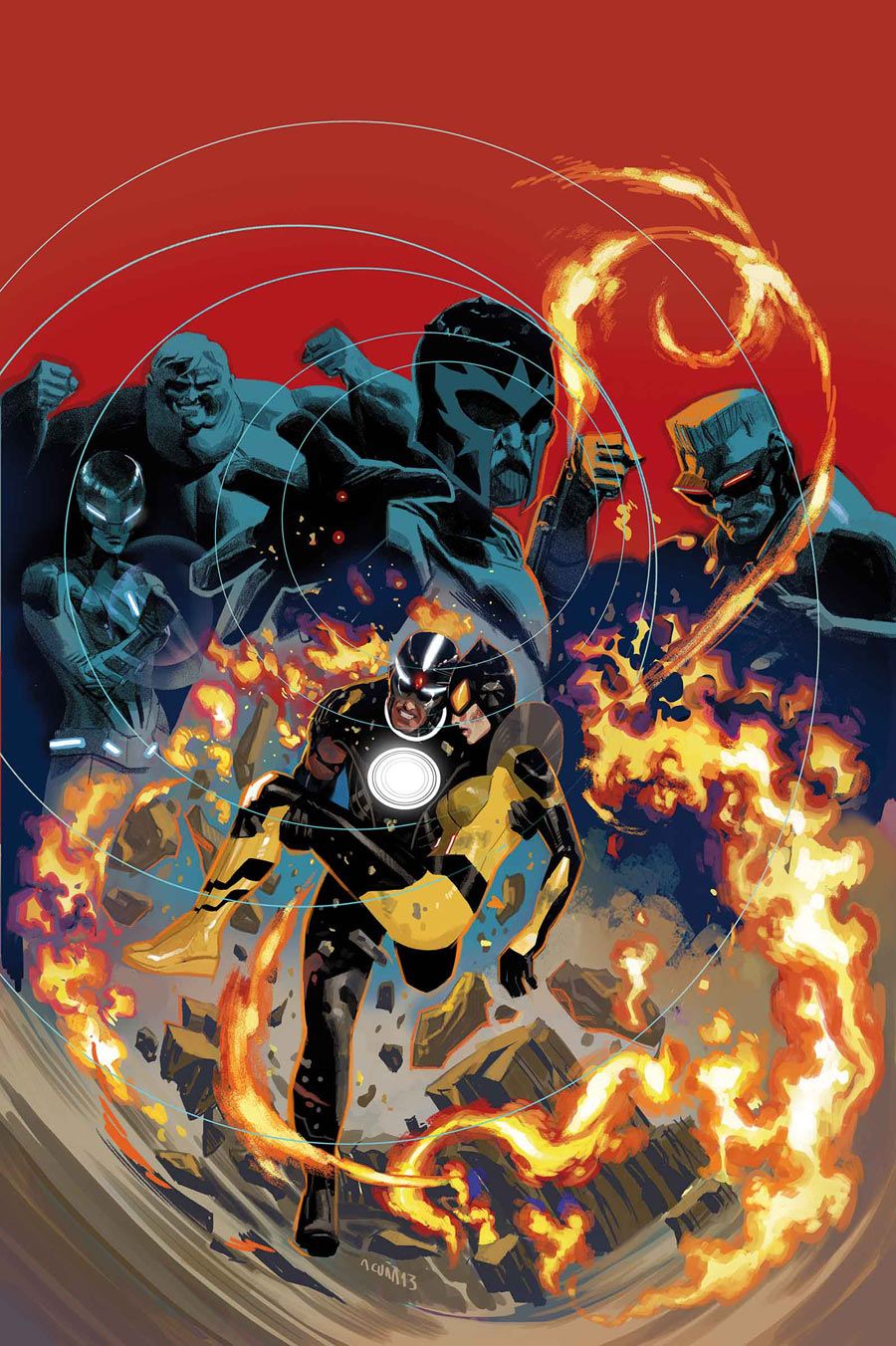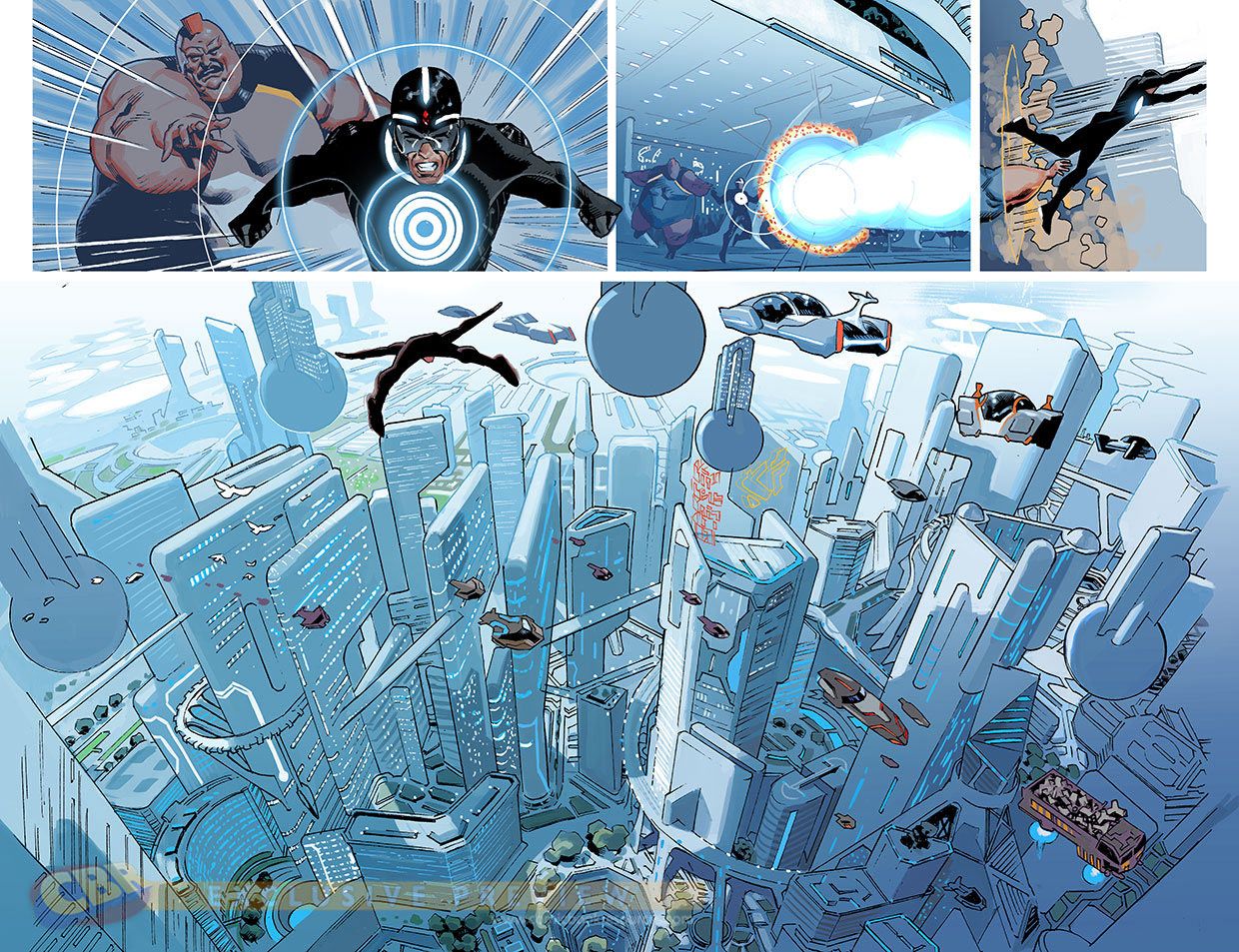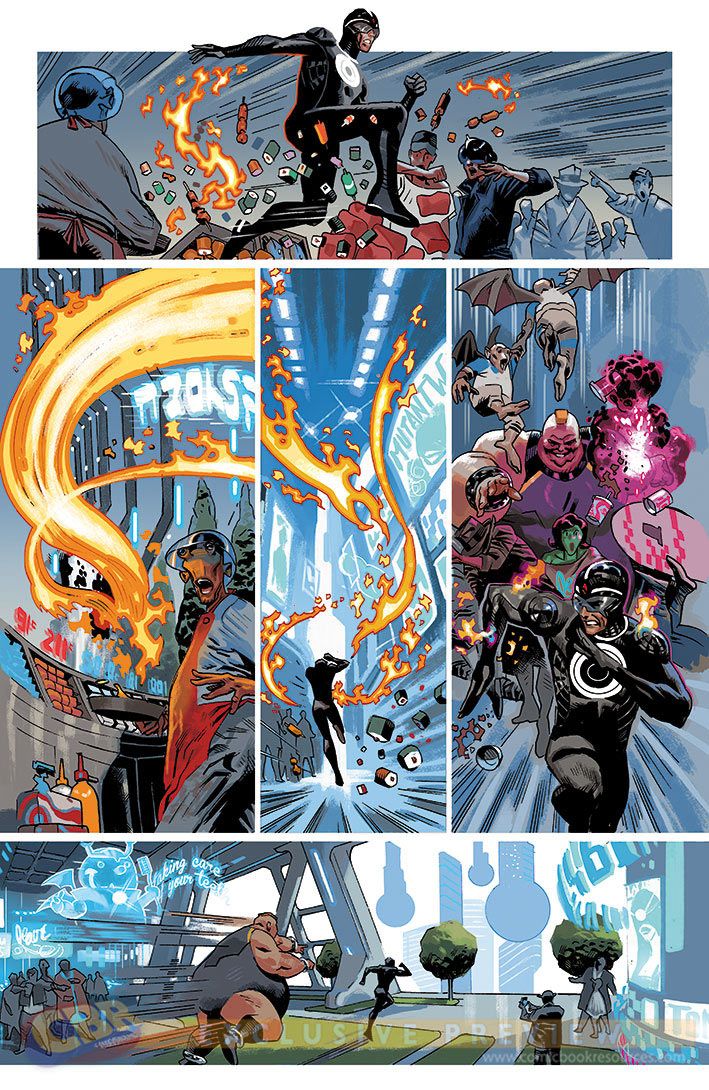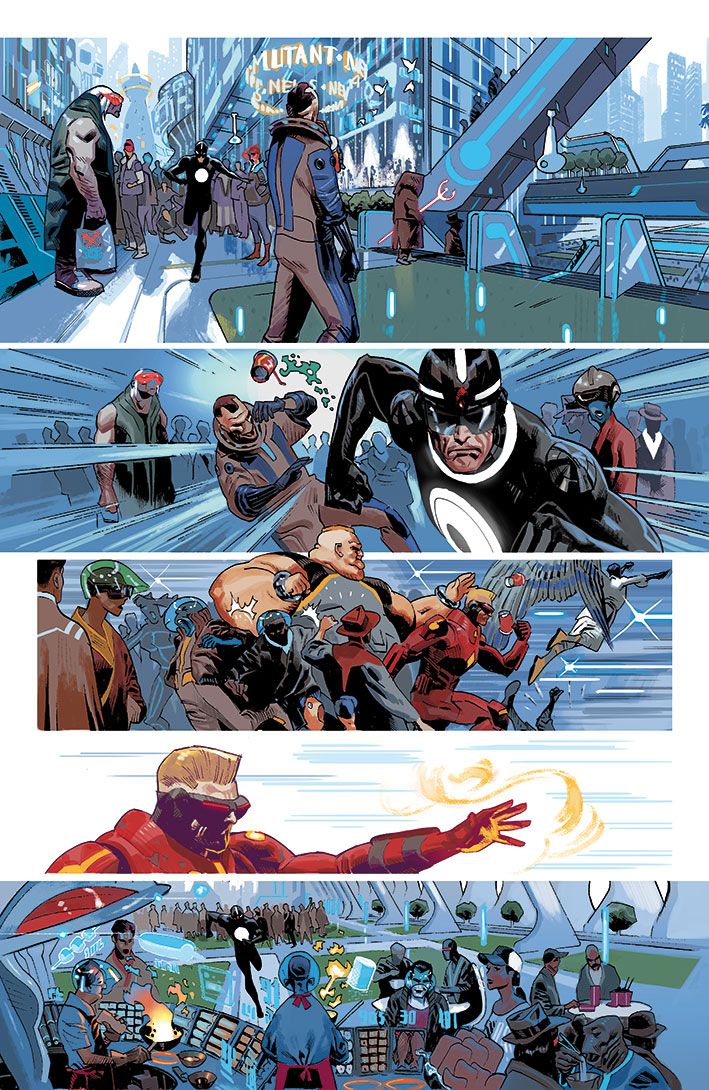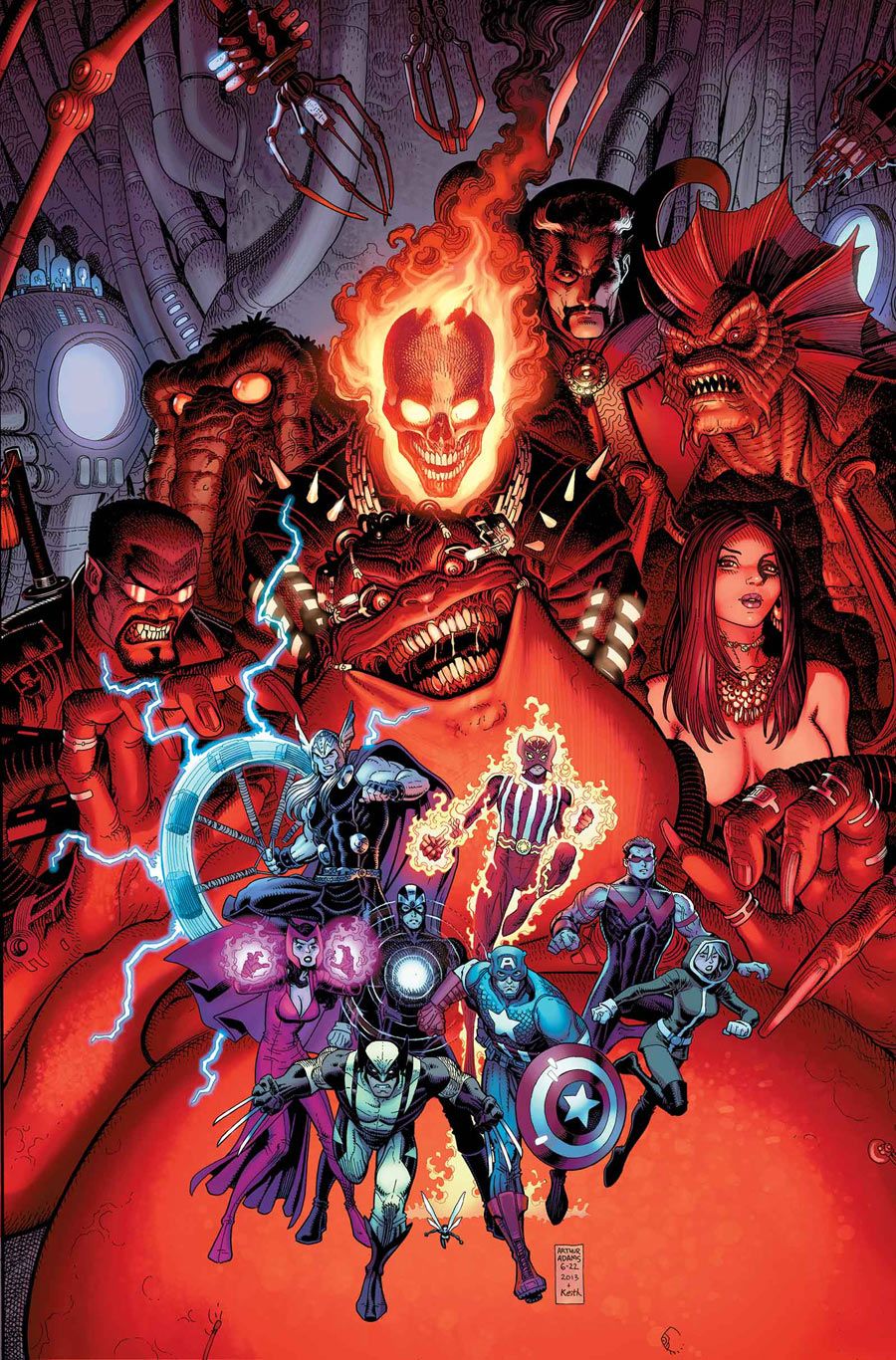The heroes of the Marvel Universe are heroic not merely because of their powers, but because of their ability to rise above the petty emotions and dark instincts that lurk within us all. When heroes unite, Earth prospers -- but when they fail, worlds crumble.
That's exactly what happened in "Uncanny Avengers" #17 by writer Rick Remender and artist Steve McNiven, the concluding chapter of "Ragnarok Now." By the end of the arc, the villainous Apocalypse Twins Eimin and Uriel exploited the strife between the members newly formed Avengers Unity Squad to accomplish a two fold plan: doom the Earth to destruction and transport the planet's mutant population into an interstellar "ark."
What happens now that the Earth is gone? What kind of world will the surviving mutant population build for themselves? And what role will the time traveling conqueror Kang and his newly forged Chronos Corps play in these events? For the answers to these questions and more, CBR News spoke with Rick Remender about the apocalyptic conclusion of "Ragnarok Now" and exploring the consequences in upcoming arc "Avenge the Earth."
CBR News: Rick, you promised that "Uncanny Avengers" would feature some of the biggest things you've ever done in a Marvel book and you delivered. How did it feel to blow up the Earth at the end of "Uncanny Avengers" #17?
Rick Remender: [Laughs] It was fun because it's also still the middle of the story. I've been enjoying the frustration via Twitter where people will come at me and throw up their hands because this isn't following what they normally understand to be continuity. That's the joy of comic books, though: you shouldn't know what to expect. This is in continuity and it does affect ongoing continuity coming up in a big way. So does "Captain America." I play a long game.
Sometimes when you get into the second act, people will get very frustrated. While I still try to keep things exciting and include plenty of suspense and fun characters, when you get into the middle of something, you're establishing what will be the emotional climax, but to have any emotion you have to spend some time building to it.
That's what we've been doing here: making our way towards the destruction of Earth leading into the "Avenge the Earth" arc, which begins with issue #18. So it's nice that the destruction of the Earth [Laughs] is the end of Act Two. We call this the "insurmountable wall." When I was doing my outline, years ago, I came to my question mark: what is my insurmountable wall for the heroes? And I actually typed out, "Earth is destroyed." [Laughs] And then I was like, "All right. That should be fun." It has been, too. I think it's going to be very exciting when I get to the end conclusion and people see what the repercussions are -- including the repercussions to the most important aspect of the story, the characters.
Speaking of those characters, you've hinted that the "Uncanny Avengers" and the two groups they draw from would pay a horrible price for their inability to cooperate. In issue #17, readers saw that price was the destruction of Earth and most of its population. Looking back at previous issues, it seems like ultimately the first two acts of this larger story you're telling were about what happens when the people of Earth don't rise above their negative emotions.
Yes, and when they fail to unite. I read a lot of speculative Futurism stuff and that's always on those maps. Humanity either unites and works as one people by a certain point -- or they kill themselves. I read that enough times that I thought it was interesting, especially coming out of "Avengers Vs. X-Men." With "Uncanny Avengers," I was taking a book that spun out of that event. When I started to build my story it was with them all working together now and it's all high fives and hugs, and at no point did I believe it.
I went through a number of drafts where Wanda and Rogue were fighting together and they were best friends. The characters were going out for drinks and dating each other. I was like, "What a bit of nonsense if you follow Marvel continuity!" With "Civil War," "Schism" and "AvX," these people have just been beating the hell out of each other. As I dug through my outline and the story I wanted to tell, I was looking for the thing I wanted to say.
What did I want to say? Well, the heroes had been fighting each other endlessly. Events don't even involve villains half the time any more, [or] just super heroes punching it out. I wanted to say that that's not very heroic. There are consequences. I built a very elaborate story around Thor's hubris and mistake early on, Wolverine's mistakes in X-Force and the emotional damage Captain America is wrestling with in the aftermath of Dimension Z. I intertwined it all and tried to tell something that would be big and exciting. Hopefully, it's a story that's surprising and heartfelt with something to say.
That was what I set out to do and we've still got another five issues of things before we get to the ultimate resolution, at which point, we pick back up with the first four issues of the series and we blow up everything all over again with the Red Onslaught.
The destruction of Earth and the battle leading up to it claimed a number of lives. Who are the surviving heroes from the Unity Squad? It looked like Thor and Wasp lived through Earth's destruction, while Wolverine, Havok and Sunfire all ended up on Eimin's mutant ark.
Yes that's correct. Thor and Wasp survived and Wolverine, Havok and Sunfire were sent to the ark along with all the other mutants that were on Earth -- except for Namor who wasn't a human mutant. He's a half human Atlantean mutant. So I didn't bring him up.
Ultimately, why did these five characters from your main cast survive? Why did you choose them to survive the events that lead up to "Avenge the Earth?"
I like Wasp a lot. I wanted to give her a prominent place. I liked that she would be the last human left. I thought that had a lot of fun potential. Keeping her alive was part of the plan from the get go and so was putting her up against something where her ideology was really put to the test. She's old school, "Avengers don't kill. We're going to find another way through this," but without the help of the mutants, they couldn't. That was the big point of a lot of the "Ragnarok Now" arc. When the mutants were gone, the Avengers fought as hard as they could and did everything they possibly could with some of their most powerful members but they still couldn't do it.
The message there is pretty clean and simple. We all need each other. Everyone needs to band together and high five, which is pretty kumbaya, but it's a pretty unifying message and I think that in the end, again as suggested by all the Futurism stuff I read, is pretty mandatory.
I picked Thor because of the contextual guilt from having created the axe that killed the Celestial. We saw Odin say in issue #6, "You have doomed the Earth with this axe." Wolverine was also chosen because of his contextual guilt having been a member of X-Force, which led to the split of the team, and for leaving the Uncanny Avengers and not fighting harder to make the cohabitation work.
I chose Havok because he and Wasp are the heart; they're going to be the glue here for a little while. I also wanted to earn the romance that I had been building since issue #7 with Wasp and Havok. Then with Sunfire you'll see why, and we've got a whole new cast of fun characters coming in. Things are going to get crazy once Kang's manipulations arise.
At the end of "Uncanny Avengers" #17, Thor enters the realm of space where Asgard used to exist and is greeted by his father, Odin. We know how Thor feels about the destruction of the Earth, but how does Odin feel about it at the end of the issue? His dialogue suggests he's quick to blame the people of Earth, but does he blame himself at all for what happened to the planet?
I don't know if he blames himself. He probably blames Thor more than he was letting on. I did tweak that scene a little bit to not make it so heavy on Thor. In my first draft, he was laying into him pretty good. Then I realized the All-Father sees all. He had predicted that the Axe would one day bring about Ragnarok. He just didn't know when, and then the Apocalypse Twins via their time manipulation and tachyon dam monkeyed everything up.
From beginning to end, the Apocalypse Twins story unfolds over a period of about six hours. Issues #7-17 are about 200 plus pages of story. So even though it took us a year to get there, you can read it in an afternoon. I wanted the story to move so quickly that questions like, "Why didn't they go get Hyperion to help?" are sort of moot. If we get too involved in the continuity, the story tends to fall apart. The simple answer to why character X isn't helping is because they're busy. Let's move on. Ultimately the shared universe is fun, but I think we are doing ourselves a disservice if we let it hobble us and stop us from telling big, exciting stories.
So issues #7-17 take place over about six hours and by the end of that time period Earth is gone. The Apocalypse Twins' attack is "pretty, pretty, pretty, pretty good." They staged things pretty well. Eimin has the ability to see time through music. She took a glimpse, they turned on the tachyon dam and off they went.
Let's move from Odin to another powerful figure, Immortus. Readers saw how the destruction of Earth affected some other time lines, but didn't see how it impacted Immortus.
Every future tied to Earth was erased. I made sure to show many of those futures falling apart and they were falling apart because the Earth was destroyed. Immortus' fate is a big question mark though, isn't it? So is the Kang of it all. If the time line is being erased, those guys probably know how to jump into another time line. At this point though, if all time lines have no Earth and there's a tachyon dam on the Akkaba ark, they can't really come back to any time near Planet X. That's where we pick up in issue #18. We deal with some of that fun.
I didn't show anything that isn't going to have some kind of role moving into the final arc of the story including Immortus, Kang, and all of those fun characters.
Is it safe to assume Immortus' Infinity Watch and Kang's Chronos Corps will both play roles in the story moving forward?
Yes.
How much story time passes between the end of "Ragnarok Now" and "Avenge the Earth?" What kind of life did the mutants on the Akkaba ark create for themselves on Planet X? How is Earth remembered on that planet?
About six to seven years pass. I don't want to give too much away other than to say that everybody who saw how the Earth was destroyed and why are dead except for Wasp. She's the last human on a planet of mutants. The mutants are starting from scratch, but with all their powers and abilities, they're able to put together a pretty sharp planet. What they build is a true mutant utopia. There's more abundance and it features a spectacular city that Magneto built in a month.
There are a few people who know the truth about what happened to Earth -- obviously Eimin and Daken, but they're not telling anybody the truth. They're blaming it all on Thor and the Avengers. So the last people that know the full truth are Havok and Wasp. Havok is seen as the last human sympathizer by a lot of people. He joined the Avengers and is viewed as a traitor to some mutants, especially Magneto and his new X-Force. They're not listening to what he has to say. In fact, they're trying to shut him up.
Has everyone united around this false history they were given?
Yeah, the reality is there's no going back to undo it. We do deal with Beast and his time travel machinations. It's all been tied together in a way that makes a lot of sense.
We've seen some hints of life on Planet X in previous issues in the form of blacked out pages with dialogue boxes where an unnamed narrator was speaking to his daughter, Katie. Based on what you've discussed about his role in this story, the symbol next to the dialogue boxes in issue #17, and the fact that his mother's name was Katherine, is it a safe to assume the narrator is Havok?
[Laughs] Hey! We didn't make it a super secret. We knew the Earth was going to blow up and what "Avenge the Earth" was going to be. So it was a nice lead in, and I've written this thing to be something that you could read twice going back to the very beginning. By the time I'm finished with the Red Onslaught and where that's going to take us, it's all one big story.
Hopefully, it will stand the test of time. One thing I enjoyed about "Uncanny X-Force" was because it was this big self-contained story that had an integrity to it in and of itself people can still go back and read that. I still get just as many new fans from people excited about "X-Force" as I do "Uncanny Avengers," or "Captain America," or "Fear Agent," or my new books like "Black Science."
I think you have to find that middle ground. You have to make it "All-Star Superman" where it has its own continuity in a sense; where you're telling your own story that doesn't require a reader to go read 20 other titles every single time, but occasionally you have to reground yourself and catch up with the greater continuity and show how your story affects it. I don't think you have to do that every single issue though. I think it hurts the story.
I understand that in the time that passes between "Ragnarok Now" and "Avenge the Earth," Havok and Wasp got married. Why did you want to pair these two characters together romantically?
When I started off, I was fiddling around with Rogue and Havok going back to some of their interactions that I was rereading in the outback era of "Uncanny X-Men." Then I realized the promise of "Uncanny Avengers" is A+X and these characters intermingling. So I started going through my cast and seeing who might be reasonable and which characters might fit.
The sort of high fashionista swagger of former Avengers leader Wasp with the volatile but desperate-to-prove-himself nature of Alex Summers, this fish out of water who's not only an Avenger now, but an Avengers leader, made for an interesting dynamic. She's heavily flirtatious with him. We've seen that throughout the last 10 issues. So it sort fell together. Those two fit -- the more I wrote them the more I liked them together, and in issue #18 we get to see them as a fully formed couple. I really like them together and I've got such big plans for both of them. I think they're a good strong couple. They're a nice place for the Avengers and the X-Men to meet.
I think their personalities as I write them work. They're both sarcastic, dry and witty. I can almost see a James Dean-style Havok with his sunglasses in a convertible with Wasp whose hair is in a bonnet and is looking like Jacqueline Onassis-Kennedy. They just seem like they fit together in a classic 1960s style.
One of the groups Havok and Wasp will encounter in "Avenge the Earth" is Kang's Chronos Corps. It's been revealed that Thor will be a part of that team. So how would you describe the overall dynamic of the Chronos Corps? It's members include heroes, villains, and some who who walk the line between heroism and villainy.
All of those characters were selected by Kang for specific reasons. Having written this so far in advance I had the benefit of knowing that I needed to do X, Y and Z towards the climax. I got to go through the Marvel Universe timelines and find the perfect representatives from the Seven Prime time lines that could then fulfill the needs of this new team. Being seen with some of these guys isn't going to help Wasp and Havok's cause. [Laughs] running around with Doom, Ahab, the Abomination and the ilk is probably not going to make people super stoked with you.
So the craziness hasn't even really started. "Avenge the Earth" is the all-action, all-crazy, all pay-off to everything you've been reading in one big way. That means character arcs as well as big, dynamic fight sequences, and the Kang of it all, which has been the B-story bubbling in the background.
Kang is not to be screwed with. Tom [Brevoort's] number one mandate when we were cooking this up was that Kang is the number one Avengers villain, and if you're going to use him you gotta have something good. So Kang is in full effect in "Avenge the Earth."
It seems like "Avenge the Earth" starts off as sort of a dystopian sci-fi adventure and then escalates into something bigger than what readers have seen so far in "Uncanny Avengers."
Yeah, it's not even dystopian. It's almost utopian. This future is not "Brave New World." Planet X is pretty all right. It's not this crushing tyrannical big brother place. You have to make the villains relatable and Eimin, even though she was willing to kill off humanity and blow up Earth to save the mutants and get back at Kang for torturing her and her brother, was willing to let her brother die and do all of these things. Her end goal has to be something that we can relate to, and her end goal is Planet X.
Everybody with an X-Gene was taken. Characters like Fred Dukes were taken and his X-Gene was reignited. This situation is not going to be as undone as everybody thinks. There's a lot of big stuff coming. If you're reading this thinking a giant reset button is coming, stick around. We're not going to tell this story and have great artists like Steve McNiven and Daniel Acuna draw these pages just to go, "And it was all undone!" Wonderful things are a-coming.
I used the dystopian analogy because it seems to me that Planet X is this utopia that's been founded on a lie. And it seems like people who know the truth could be declared enemies of the state by people who shaped that fictional history. Is that true?
Yes, it is true. Cyclops and the X-Men run Planet X. Eimin's control is more from the shadows. There're definitely some dystopian elements in terms of that, but it is a free society, or at least its citizens think it is.
The great lie is that this was all because of Thor and the Avengers. So the Avengers are detested. They're viewed as monsters, and the Scarlet Witch is now seen as this grand savior who ascended them to the heavens when the celestial monsters came.
Does the Planet X setting of "Avenge the Earth" mean that we'll get some new characters front and center and perhaps some fun cameos from various mutants?
Yeah, but I don't want to bog the story down too much with getting into that. We're going to have a big Havok and Cyclops confrontation here, or possibly several. There's a lot of that coming. We're going to get a lot of contextual stuff based around the mutants on Planet X and some of our cast. Then when the action picks up I had to of course throw Psylocke in there. So she's around, a couple versions of her actually. If you read "Uncanny X-Force" this will be a nice continuation of the "Kill the Future" arc. There's a lot of Easter eggs, but as always, I try to make sure that the story is accessible to new readers.
A confrontation between Havok and Cyclops suggests that this will be a story with developments for the Summers family. So will Cable be part of this story as well?
Yes.
Wrapping up, let's focus a bit on visuals. In the past, we talked about Daniel Acuna's great character designs for this story. What other strengths did he bring to this arc?
His character designs are magnificent, but his set designs are tremendous as well. He had already mostly designed Planet X. The Apocalypse Twins showed it a few issues back. I believe it was in issue #9 or #10. So beyond his character and set designs what's on display in issue #18 is his ability to tell fluid action.
Issue #18 is me leaning into the beated out action that I love to get into. I realized that other than issue #6 where we had Thor versus Apocalypse I haven't really told one steady cam action story in this book. It's a thing that I love, and I think that I sometimes talk my self out of it because I worry that I'm leaning on it too much, but now that I've done it I realize that the climax is all going to be this fluid action. We get to have Acuna come in and deliver this spectacular cinematic performance. In issue #18, we get to see Havok and Wasp, a well-oiled machine of kicking ass, up against Magneto and his X-Force, and it's a steady cam. We just follow them from beginning to end. There's no cuts. It's just them, so you get to see Acuna at his very best. He's redesigning all the mutants on this new world created by Magneto and his fellow mutants, and you get to see this fluid, wonderful action piece that I think people are going to have a lot of fun with.
Finally, you have another "Uncanny Avengers" storyline coming in April with the release of the series' first Annual. Which characters will be the focus of the book? What can you tease about the plot?
You've got the full cast of "Uncanny Avengers" and then you've got Doctor Strange, Satana, Man-Thing, Blade, Manphibian and Ghost Rider.
We're unveiling some of the Avengers of the Supernatural in a pretty fun way. Instead of the traditional, "Here's a situation that needs some Avengers" it's, "Hey, Mojo wants to make a new show that gets some good ratings." It not only balances the A and the X, but we're dabbling in the supernatural stuff as well. It's going to be a fun romp. My good friend Paul Renaud did all of the art; pencils, inks, and color. It's a visual masterpiece and features a gorgeous cover by Art Adams.
It's approximately 32 pages and it explores the idea that the Spirit of Vengeance is the real threat that I think it is. It's something that might set up some cool stuff down the road, too. Without getting too much into that, I will say this is a story that I've wanted to tell for a long time. The characters in this story: the monsters and Ghost Rider are some that I always wanted to get my hands on. The new version of Ghost Rider that they're doing looks great and seems really terrific, but this is classic Johnny Blaze Spirit of Vengeance, and what happens when you tweak that too much and release the Spirit of Vengeance. The fact that it happens in Mojoworld means that the story is going to be a lot of fun. It's a very visual comic book, and it's a classic Marvel annual. I wanted to do something that was a tip of the hat to the old Marvel Annuals that I grew up reading.


